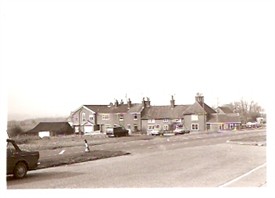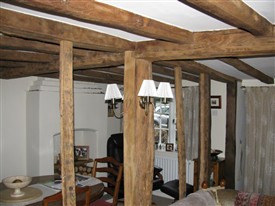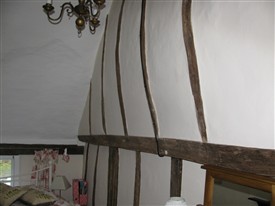Forge Cottage - a brief history

Chapel Road seen from Maidstone Road with the Forge complex on the right
Taken in 1980, Courtesy David Millar

Forge Cottage has a wealth of beams
Photo kindly provided by Steve and Jane Clark

Upstairs in Forge Cottage
Courtesy of Steve and Jane Clark
On the Westwell/Hothfield border
By Steve, Jane and Claire Clark
The cottage was listed grade 2 in 1986 and has stood on site since around 1650 at that time the English civil war was coming to an end and soon after the English were fighting sea battles with the Dutch just of the coast near Dungeness. Then, and until relatively recently, the building was officially in the Parish of Westwell.
The cottage may well have stood on its own with no other buildings around and may well have been a forge at that time. I have recently learned iron working may well have taken place nearby possibly where the retirement village is now and local parish records from around 1650-1622 show that several people with names that link them to the iron history were recorded.
The Reverend Russell, rector of Hothfield until he died, researched the Parish up to 1902. In his extensive manuscripts, since transcribed by the History Society, he refers to 'Brick Field' and Forge Field. He wrote: "Forge Field is on the west bank of the stream from Westwell, & is opposite to Grafty Field. In the 17thcentury the iron trade was carried on in this Parish; & an artificial depression in this field near the stream was probably the site of the workings."
The Listed Buildings register tells us the front elevation of the cottage was bricked up around the end of the seventeenth century a wing now called Myrtle Cottage was added and the forge complex was born.
As time moved on the village of Hothfield and the market town of Ashford grew as did the forge complex. It became a blacksmiths, farriers and wheelwrights you can still see the wheelwrights tyre ring in the floor outside the white cottage known as (The Old Forge) on Maidstone road (A20) by the bus stop opposite the Woolpack inn.
In Victorian times the houses to the left of the cottage and the wesleyan chapel were built and Forge cottage became terraced. This meant that the rear pitched roof needed to be modified to allow the roof to drain therefore the rear pitched roof was removed and a partial flat roof was fabricated in its place and this layout remains the basis of Forge Cottage today.
The forge complex was still in use in the nineteen twenties and was bought by local blacksmith William White for £375 from the local landowner when the Hothfield estate was broken up. ‘The Old Forge’ was still functioning as a workshop right up till the nineteen seventies. It now finds itself in the Parish of Hothfield as the boundary, which previously crossed the 'common' (Hothfield Heathlands), moved to the Ashford-Maidstone Road (A20).
As you can see the cottage has a long history and we hope you find this information interesting.
by Steve, Jane and Claire Clark our own family archivist